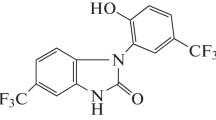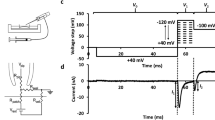Abstract
In rat skeletal muscle, taurine was proposed to interact with a low affinity binding site on sarcolemmal phospholipids near chloride channel, increasing chloride conductance (GCI). In an attempt to evaluate the structure-activity relationship between taurine and its binding site, a series of N-azacycloalkenyl analogues of taurine (A: N-(1′aza-cyclopenten-2′yl)-2-aminoethane sulfonic acid; B: N-(1′-aza-cyclopenten-2′-yl)-2-aminoethane sulfonic acid; C: N-(1′aza-cyclopenten-2′-yl)-3-amino-propane sulfonic acid; D: N-(1′aza-cyclopenten-2′-yl)-3-aminopropane sulfonic acid) have been synthetized and tested in vitro on rat extensor digitorum longus (EDL) muscle. In spite of the presence of a bulky and lipophilic 5 or 7 membered heterocycle linked to the taurine amino group, analogues A and B determined an increase of GCI, although less potently than taurine. Also 3-aminopropane sulfonic acid (homotaurine), tested in comparison, showed less activity in increasing GCI with respect to taurine, probably for the increased distance between charged groups. Taurine analogues C and D, which differ from compounds A and B for an additional methylene group, showed much lower activity in increasing GCI. It has been reported that guanidinoethane sulfonate (GES) displaces taurine from the low affinity site on sarcolemma by only 7%. This compound, characterized by lower charge density on the guanidinium cationic head, applied in vitro on EDL muscle, show reduced taurine-like activity in increasing GCl. Our results support the hypothesis that the effect of taurine on muscle GCI is due to a specific binding on a low affinity site on sarcolemma and that charge delocalization reduces the binding probability more than the substitution of the primary amino group or the increased distance between charged groups.
Similar content being viewed by others
References
Adrian RH, Bryant SH (1974) On the repetitive discharge in myotonic muscle fibres. J Physiol 240:505–510
Boyd IA, Martin AR (1959) Membrane constants of mammalian muscle fibres. J Physiol 147:450–457
Bryant SH (1969) Cable properties of external intercostal muscle fibres from myotonic and nonmyotonic goats. J Physiol 204:539–550
Bryant SH, Conte Camerino D (1991) Chloride channel regulation in the skeletal muscle of normal and myotonic goat. Pflügers Arch 417:605–610
Conte Camerino D, De Luca A (1989) Pharmacological models in the study of hereditary myotonic disease. In: Gorrod JW, Albano O, Papa S (eds) Molecular aspects of human disease, Vol. 1. Ellis Horwood, London, pp 151–156
Conte Camerino D, Franconi F, Mambrini M, Bennardini F, Failli P, Bryant SH, Giotti A (1987) The action of taurine on chloride conductance and excitability characteristics of rat striated muscle fibers. Pharmacol Res Commun 19:685–701
Conte Camerino D, Mambrini M, De Luca A, Tricarico D, Bryant SH, Tortorella V, Bettoni G (1988) Enantiomers of clofibric acid analogs have opposite actions on rat skeletal muscle chloride channels. Pflügers Arch 413:105–107
Conte Camerino D, De Luca A, Mambrini M, Ferrannini E, Franconi F, Giotti A, Bryant SH (1989) The effects of taurine on pharmacologically induced myotonia. Muscle & Nerve 12:898–904
De Luca A, Pierno S, Huxtable RJ, Failli P, Franconi F, Giotti A, Conte Camerino D (1992) Effects of taurine depletion on membrane electrical properties of rat skeletal muscle. In: Lombardini JB, Schaffer SW, Azuma J (eds) Taurine nutritional value and mechanism of action, Vol 315. Plenum Press, New York, pp 199–205
Eisenberg RS, Gage PW (1969) Ionic conductance of the surface and trasverse tubular membranes of frog sartorius fibers. J Gen Physiol 53:279–297
Franconi F, Martini F, Manghi N, Galli A, Bennardini F, Giotti A (1981) Uptake of [3H] taurine into myocardial membranes. Biochem Pharmacol 30:77–80
Franconi F, Failli P, Stendardi I, Matucci R, Bennardini F, Baccaro C, Giotti A (1986) Positive inotropic effect of some taurine-related compounds on guinea-pig ventricular strips perfused with low calcium medium. Eur J Pharmacol 124:129–133
Furman RE, Barchi RL (1981) 20, 25-Diazacholesterol myotonia: an electrophysiological study. Ann Neurol 10:251–260
Green JR, Margerison D (1978) Statistical treatment of experimental data. Elsevier, New York, pp 86–88
Huxtable RJ (1992) The physiological actions of taurine. Physiol Rev 72:101–163
Huxtable RJ, Sebring LA (1986) Towards a unifying theory for the action of taurine. TIPS 7:481–485
Huxtable RJ, Laird HE, Lippincott SE (1979) The transport of taurine in the heart and rapid depletion of tissue taurine content by guanidinoethyl sulfonate. J Pharmacol Exp Ther 211:465–471
Lleu P-L, Huxtable RJ (1992) Phospholipid methylation and taurine content of synaptosomes from cerebral cortex of developing rat. Neurochem Int 21:109–118
Palade PT, Barchi RL (1977) On the inhibition of muscle membrane chloride conductance by aromatic carboxylic acids. J Gen Physiol 69:879–896
Pato CN, Davis MH, Doughty MJ, Bryant SH, Gruenstein E (1983) Increased membrane permeability to chloride in Duchenne muscular dystrophy fibroblasts and its relationship to muscle function. Proc Natl Acad Sci USA 80:4732–4736
Rüdel R, Lehmann-Horn F (1985) Membrane change in cells from myotonia patients. Physiol Rev 65:310–356
Sturman JA (1993) Taurine in development. Physiol Rev 73:119–147
Wu JY, Tang XW, Tsai WH (1992) Taurine receptor: kinetic analysis and pharmacological studies. In: Lombardini JB, Schaffer SW, Azuma J (eds) Taurine nutritional value and mechanisms of action, Vol 315. Plenum Press, New York, pp 263–268
Author information
Authors and Affiliations
Additional information
Correspondence to: D. Conte Camerino at the above address
Rights and permissions
About this article
Cite this article
Pierno, S., Tricarico, D., De Luca, A. et al. Effects of taurine analogues on chloride channel conductance of rat skeletal muscle fibers: a structure-activity relationship investigation. Naunyn-Schmiedeberg’s Arch Pharmacol 349, 416–421 (1994). https://doi.org/10.1007/BF00170889
Received:
Accepted:
Published:
Issue Date:
DOI: https://doi.org/10.1007/BF00170889




